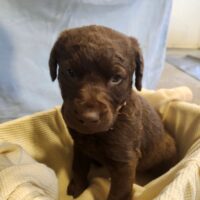
Learning how to train hunting dogs may be one of the most enjoyable and rewarding things we accomplish in our entire lives. On the other hand, training dogs may be something that causes you to pull your hair out and never own a dog again! You have to decide for yourself if you want to do it on your own or hire a professional. This page will point you in the direction of what training entails and help you make an informed decision on which direction you want to partake.
Here are some basic human characteristics you should ask yourself if you possess before taking on the sole job of training your hunting partners.:
- Time
- Patience
- Sense of humor
- Creativity
- Access to birds for training
- Knowledge of dog training equipment
Training your own dog can be extremely rewarding, but if you are not able to adhere to most of the above attributes, you should strongly consider hiring a professional.
How to Train Bird Dog Pups {Pointing Dogs}
How to Train Your Pointing Dog Pup {Step One}

One of the best ways to teach new pups to point is to tie a wing of a gamebird you prefer to hunt on a fishing line. Tease the pup with the bird and then let it set on the ground several feet from him. DO NOT LET THE PUP CATCH THE WING! When he gets tired of chasing it he will start to stop and lock up on it. This is where Whoa begins. Continue saying whoa, he will probably hold this for a minute and then try to pounce on the wing again. Repeat the same steps, continuing to say whoa when he locks up. If you have a friend that will help, have them work the fishing rod and you work the pup. After he has done this for awhile, go over to him and gently push his shoulders forward. This will make him firmer. PRAISE your dog as you are doing this. Do this every few days for about 10-15 minutes. Do not over do it. Have fun and end the day with encouragement an enthusiasm. Make sure you offer him a treat at the end.

When you start feeling comfortable with the wing you will want to purchase an Orange 30 foot long check cord. This will be used exactly as its name implies – to keep your dog in check. If possible try and purchase some pigeons or chukars for this task. You will also want to purchase a pigeon restraint. This is a harness that will fit over a pigeon or quail to have your dog practice pointing it. Have a rope or cord on the harness connected to some type of long pole. This way you can pick the bird up to not let the dog catch it and the bird can’t walk off for good. When putting the bird out it helps to move the bird around in about a 2-3 foot radius. This helps the bird develop a scent cone so the dog can smell it easier. Make sure you dizzy the bird before setting it in place. Try and put the bird down so it is partially hidden. The more you practice this, the more you want to become innovative by hiding the bird under trees, by logs or in a bush. This helps the pup get used to real life situations. Slowly work the dog in the direction of the bird. DO NOT take the dog directly to the bird, let him gradually find it. When you see him start to get birdy do not let him rush in and get the bird. Let him get about 4 – 6 feet from it and start pulling up on the check cord telling him Whoa. Use the same techniques you did with the bird wing. Push him gently forward and make him stiffen up. Stroke his tail up to get him preppy.
It really helps to have a partner when performing this process. Someone who can control the bird and the pole to pull the bird up as if that person flushed the bird. Just like if you were out hunting. This is a great way to get the whole family involved. Make sure everyone is on the same page when doing this process so as not to create confusion and mixed signals for the dog. Practice this for about a half hour 2-4 times per week. Don’t over do it and make sure you heap praise on your hunting companion.
As you progress with the dog’s training make sure that you slowly go out to fields that have taller grass. Keep him on the check cord to start with. Sometimes when planting birds it helps to tie a ribbon near where the bird is planted so it is easier to remember it’s location. It is easy to get mixed up if you are doing this process alone and trying to keep everything in your control. It also helps because you want to be able to control your dog and not let him get to close to the bird before pointing. It will help him learn not to crowd birds such as grouse.
This training step will help you start to assimilate real life situations. If you are a grouse hunter you can start taking your dog out and planting birds in the brush. Purchase a small bird launcher so you can use this to create real life bird flushing. You can purchase a bigger launcher in time. Small birds such as quail, chukars and pigeons are much easier on the pocketbook than pheasants. Practice this regularly until your dog has it down.










